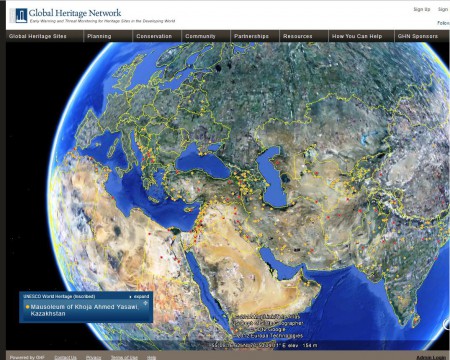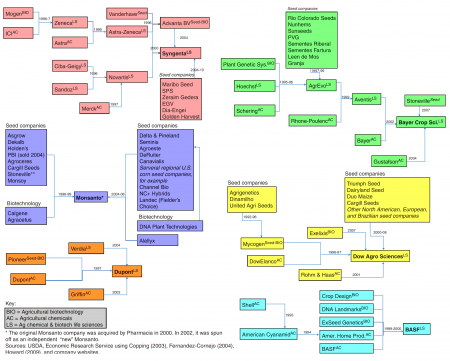- Higher maize yields? Plant cover crops between the rows.
- Barley tempeh! My kind of food exploration.
- Danny Hunter impresses Irish Times with need to conserve biodiversity.
- UK devotes millions to research for “bigger yields of better quality fruits and vegetables”.
- Germans embrace high-tech urban agriculture — cautiously.
- Put farmers’ markets near medical centres for added benefits. What happens when everyone’s so healthy they don’t need the doctor?
Consolidation in the seed industry
We’ve written before about consolidation in the seed industry making the same tired joke that I want to make again now, that a picture is worth 1000 words. It doesn’t hurt to stay up to date though, which is why I am grateful to Resources Research for finding, and colouring in, the diagram from the USDA report on Research Investments and Market Structure in the Food Processing, Agricultural Input, and Biofuel Industries Worldwide.
The USDA report is not, as far as I can tell, anything to do with the US Department of Justice’s investigation of antitrust practices in the seed industry, announced a couple of years ago. So what has become of that? Anyone know?
How to react to emergencies
From early 2000, various agencies and individuals involved in livestock relief work began to question the quality and professionalism of their interventions.
Wow, thanks for sharing. Anyway, out of that crisis of self-esteem was LEGS born, the Livestock Emergency Guidelines and Standards. It’s not immediately clear to me after a brief browse of the website to what extent agrobiodiversity considerations come into these standards and guidelines, but I’ll explore some more and get back to you. Anyone out there aware of a similarly formalized initiative for seeds? It’s not as if guidelines for seed interventions are not needed. But they may be there already for all I know, embedded in the WFP and FAO seed relief playbooks.
LATER: And indeed they are. Good to know. Thanks to Tom Osborn from FAO.
Nibbles: Canis then and now, Training roundup, Soybean genome, Top 10 viruses, PNG drought, Food archaeology, Sturgeon Bay, Moringa
- Dogs were first domesticated animal. But the love affair is cooling off, at least for some breeds.
- Building capacity for animal genetic resources use, and for conservation and sustainable use under the ITPGRFA. And tree domestication. Is someone keeping track?
- BGI continues to take over DNA world.
- And the Worst Plant Virus Oscar goes to…
- How PNG farmers cope with drought. From what is developing into a really useful blog.
- I wish I had time to read 200 pages on ancient Athenian food. But maybe you do?
- Learn about the USDA potato collection, including lots of wild relatives.
- The tree that thinks it’s a supermarket: Moringa in the limelight again.
Early warning system for heritage sites online
A propos of that idea to have a mobile phone app for documenting erosion of agricultural biodiversity. Only fair to say that the Global Heritage Network have a website that records threats to heritage sites. Can the app be far behind?

LATER: Or it did. I can’t get it to work.
